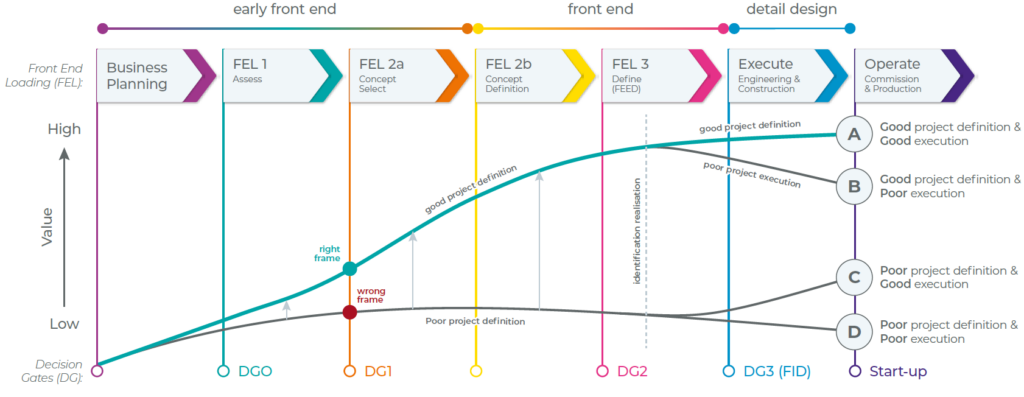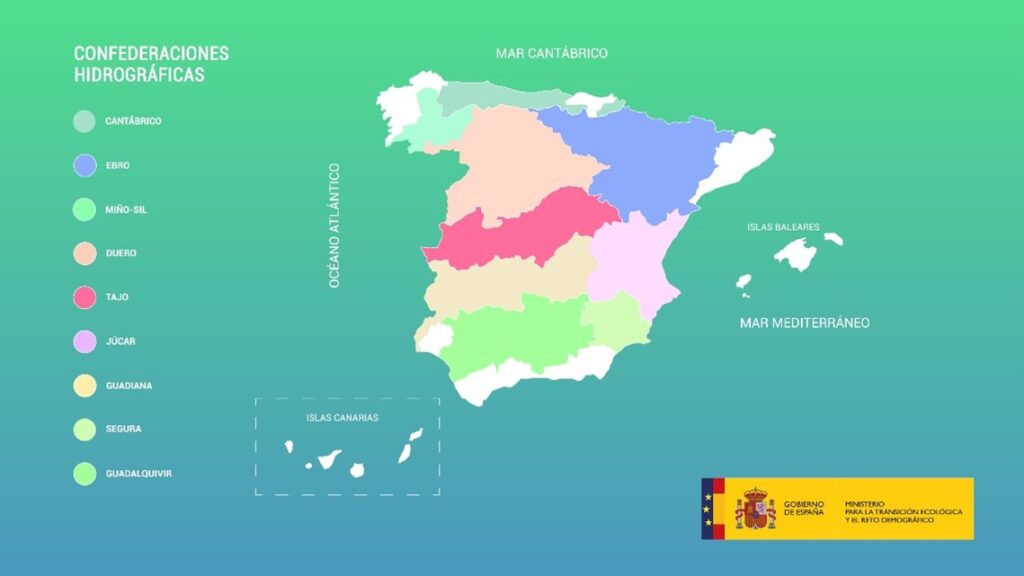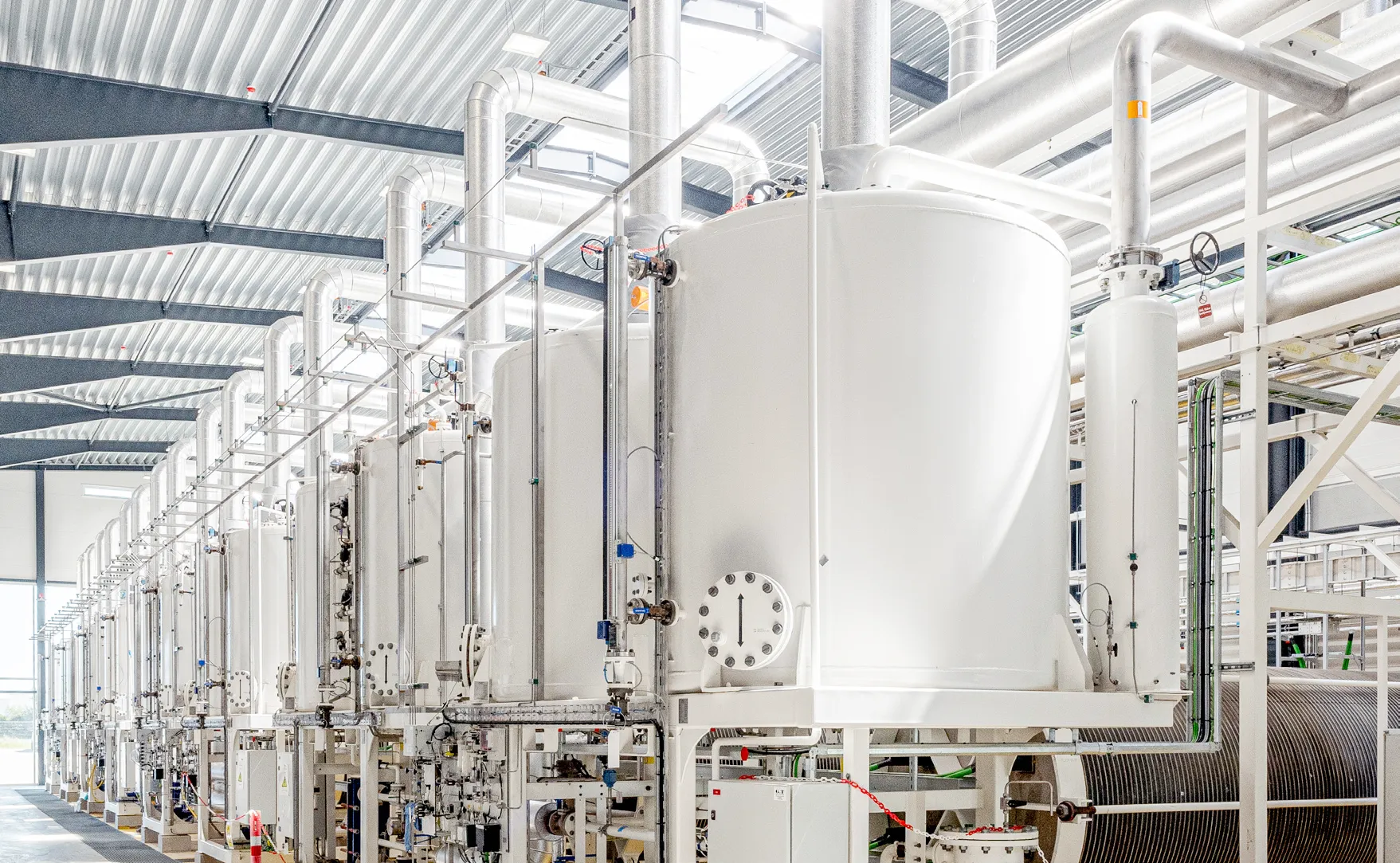Taking a hydrogen project from the initial concept stage—when the opportunity is first identified—through to the moment the production plant begins operation is a multi-year process that can be divided into several development phases.
Having a clear understanding of the phases, as well as the tasks and permitting status associated with each of them, is a key factor in ensuring the project’s success.
In this article, we’ll review the main tasks that need to be completed to reach a Ready-to-Build (RtB) stage in a hydrogen project.
Project phases
Engineering development
From an engineering perspective, three main phases can be identified (Illustration 1), based on the level of progress in project development:
- Conceptual or administrative engineering: Starting from the initial idea, this phase focuses on assessing the project’s technical and economic feasibility, with an estimated accuracy margin of ±40%. During this stage, the economic model begins to take shape, potential stakeholders are identified and contacted, and the first evaluation of available technologies is carried out. It spans from initial conceptualisation up to the point where the project is sufficiently defined: including equipment, consumption, occupied area, effluents, and more. This level of engineering is sufficient to obtain all the permits discussed in this article, and it is the scope of engineering we deliver at AtlantHy. Using the well-known FEL terminology, this would typically cover up to FEL 2a.
- Basic engineering: Based on the outcomes of the previous stage, more detailed designs are developed, focusing on critical technical and economic aspects. This phase provides key project parameters such as CAPEX and OPEX estimates, significantly reducing the uncertainty inherent in conceptual engineering. Basic engineering generally covers FEL 2b to FEL 3, and is followed by the Final Investment Decision (FID), as the project’s cost and revenue structure is now well understood.
- Detailed engineering: This final phase involves the development of detailed engineering designs that enable the physical construction and commissioning of the plant. At this stage, the project is technically and practically ready for implementation and operation.

Illustration 1. Main phases in the development of a hydrogen project.

Illustration 2. Engineering project development phases.
Key permitting procedures
In addition to engineering development, various procedures and permits must also be processed in parallel with the relevant authorities. This includes, for example, the environmental impact assessment resolution, authorisation for water use, the integrated environmental permit, and the request for a grid connection point from Red Eléctrica Española, among others.
Water use permitting
As for the permitting process for water use, this is a key parameter for any hydrogen production plant, as water is used as a raw material in the electrolysis process. During electrolysis, water is split into hydrogen and oxygen molecules, and based on the stoichiometric reaction, approximately 9 litres of water are required to produce one kilogram of hydrogen. However, inefficiencies in water treatment, as well as additional needs—such as for cooling—can raise consumption to as much as 30 litres per kilogram of hydrogen. We will explore this topic in much more detail in a dedicated article.
This permitting process must be carried out with the competent authority, which in most of Spain is the Confederación Hidrográfica (River Basin Authority) corresponding to the location of the project (Illustration 3). It is regulated by Royal Legislative Decree 1/2001, of 20 July, which approves the consolidated text of the Water Law, and by Royal Decree 849/2016, of 11 April, which approves the Regulation of the Public Hydraulic Domain (Ministerio para la Transición Ecológica y el Reto Demográfico, n.d.).

Illustration 3. River Basin Authorities in Spain. Source: (Confederación Hidrográfica del Cantábrico, 2023).
Grid connection
Connecting a hydrogen production plant to the Spanish electricity grid (Red Eléctrica Española – REE) is subject to Royal Decree 1183/2020 of 29 December, which regulates access to and connection with electricity transmission and distribution networks. If the plant exceeds 50 MVA, the procedure must be carried out with REE, as it is both the system operator and the owner of the transmission grid. This process can take approximately one year from the initial application to the signing of the Technical Access Agreement (CTA).
It is important to highlight that this procedure can only be carried out in relation to existing substations, or those included in the current transmission grid development plans. Given the complexity and importance of this topic, we will explore it in greater depth in future publications.

Illustration 4. Alkaline electrolyser (HYDROGENPRO).
Environmental permitting
Environmental permitting is a key requirement for the development of most industrial facilities. Two main types of permits are involved: the Environmental Impact Assessment (EIA) and the Integrated Environmental Authorisation (AAI). Both are essential for the plant’s operation, although they are required at different stages of the project. They are typically processed in parallel, alongside the technical development of the project—before reaching the detailed engineering phase.
At this stage, several questions often arise regarding these authorisations—questions we aim to address in this publication:
- What is an Environmental Impact Assessment (EIA)?
- What is an Integrated Environmental Authorisation (AAI), and how does it differ from an EIA?
- When should the permitting process for each of them begin?
- How can I determine whether a project requires an EIA? Is an EIA required for a hydrogen production plant?
- How long does it take to obtain an Environmental Impact Assessment? And what about the Integrated Environmental Authorisation?
– Environmental Impact Assessment (EIA)
The Environmental Impact Assessment is established under Spanish legislation in Law 21/2013 of 9 December on environmental assessment, along with its subsequent amendments. It is an administrative document aimed at identifying, assessing, and preventing the significant effects that projects may have on the environment (Boletín Oficial del Estado – BOE, 2013). In other words, it is a permit required prior to the start of construction, and it considers all potential impacts of the project throughout its lifecycle—including construction, operation, and eventual decommissioning.
In the specific case of hydrogen production plants, these are included under Annex I, as they are classified as industrial installations for the production of inorganic chemicals. To initiate the permitting process, it is necessary to submit documentation to the relevant environmental authority, which may also be asked to issue guidance on the documentation required for the associated Environmental Impact Study. And what should be included in the Environmental Impact Study (EIS or EsIA—Estudio de Impacto Ambiental, in Spanish)? The core scope of this document is outlined in Annex VI, and includes the following:

Illustration 5. Administrative procedure for environmental impact assessment permitting.
As for the application process, this is a procedure subject to public consultation, and the resolution may take around 9 months. For this reason, it is advisable to start the process well in advance—once the most relevant project information is available, typically in the early phases.
– Integrated Environmental Authorisation (AAI)
The Integrated Environmental Authorisation (IEA or AAI—Actualización Ambiental Integrada, in Spanish) is the permit that allows an industrial plant to operate, and it requires prior approval of the environmental impact assessment. This authorisation, along with the associated obligations for the company, is set out in Royal Legislative Decree 1/2016 of 16 December, which approves the consolidated text of the Law on Integrated Pollution Prevention and Control (Boletín Oficial del Estado – BOE, 2016).
Once again, this is a procedure subject to public consultation, and it typically takes around one year to obtain, although in some cases it may take longer. The official procedure is shown in Illustration 6. In this case, the same information required in the EIS (EsIA) must be submitted, along with an urban planning report, documentation required for discharge authorisation, a soil and groundwater report, and a basic engineering project. This last document must be more detailed and comprehensive than the one submitted for the Environmental Impact Assessment, which is why this procedure usually begins at more advanced stages of project development.

Illustration 6. Application procedure for the Integrated Environmental Authorisation (AAI).
Discharge authorisation
The discharge authorisation documentation must be submitted to the competent authority responsible for issuing the AAI, which will then forward it to the relevant river basin authority (confederación hidrográfica). The river basin authority has a period of six months to issue a binding report on discharge matters.
To carry out this procedure, the process must follow the provisions set out in Order AAA/2056/2014 of 27 October, which approves the official application and discharge declaration forms (Boletín Oficial del Estado – BOE, 2014).
Other procedures
In addition, it’s important to remember that industrial projects of this nature also require other types of permits, such as construction permits, operating licences, and so on—which will be covered in more detail in an upcoming article.
Conclusions
Permitting a hydrogen project requires time, investment, and patience. Like a conductor leading an orchestra, all elements must be coordinated—not only to minimise the risk of complications, but also to ensure that, by the time the AAI is obtained, the project is technically sound and well-structured. This is precisely the kind of support we provide at AtlantHy.
We recommend listening to our episodes with our friends at Watson Farley & Williams (Episode 16, Episode 56 I, and Episode 56 II) to learn more about all the legal aspects involved in project permitting.
Don’t forget that at AtlantHy we support companies from the very origin of their projects through to the granting of the AAI, taking care of all the necessary steps for the technical and commercial definition of the project, the required engineering work, and technology selection, among many other aspects. We also work with top-level experts to support us in the environmental side of things—covering both the EsIA and the AAI.
Don’t hesitate to get in touch—let’s get your project off the ground!
If you enjoyed this article, stay tuned for the next part, where we’ll dive deeper into each of the permitting procedures… Follow us on AtlantHy Academy to keep learning!
References
Boletín Oficial del Estado (BOE). (2013). Ley 21/2013, de 9 de diciembre, de evaluación ambiental. Retrieved from https://www.boe.es/eli/es/l/2013/12/09/21
Boletín Oficial del Estado (BOE). (2014). Orden AAA/2056/2014, de 27 de octubre, por la que se aprueban los modelos oficiales de solicitud de autorización y de declaración de vertido. Retrieved from https://www.boe.es/eli/es/o/2014/10/27/aaa2056/con
Boletín Oficial del Estado (BOE). (2016). Real Decreto Legislativo 1/2016, de 16 de diciembre, por el que se aprueba el texto refundido de la Ley de prevención y control integrados de la contaminación. Retrieved from https://www.boe.es/eli/es/rdlg/2016/12/16/1/con
Confederación Hidrográfica del Cantábrico. (febrero de 2023). Las Confederaciones Hidrográficas. Retrieved from https://www.chcantabrico.es/organismo/confederaciones-hidrograficas
Ministerio para la Transición Ecológica y el Reto Demográfico. (s.f.). Usos del Dominio Público Hidráulico: Concesiones y Autorizaciones. Retrieved from https://www.miteco.gob.es/es/agua/temas/concesiones-y-autorizaciones.html
Red Eléctrica. (s.f.). Acceso y conexión a la red. Retrieved from https://www.ree.es/es/clientes/consumidor/acceso-conexion/normativa-guias-formularios-y-otra-documentacion
